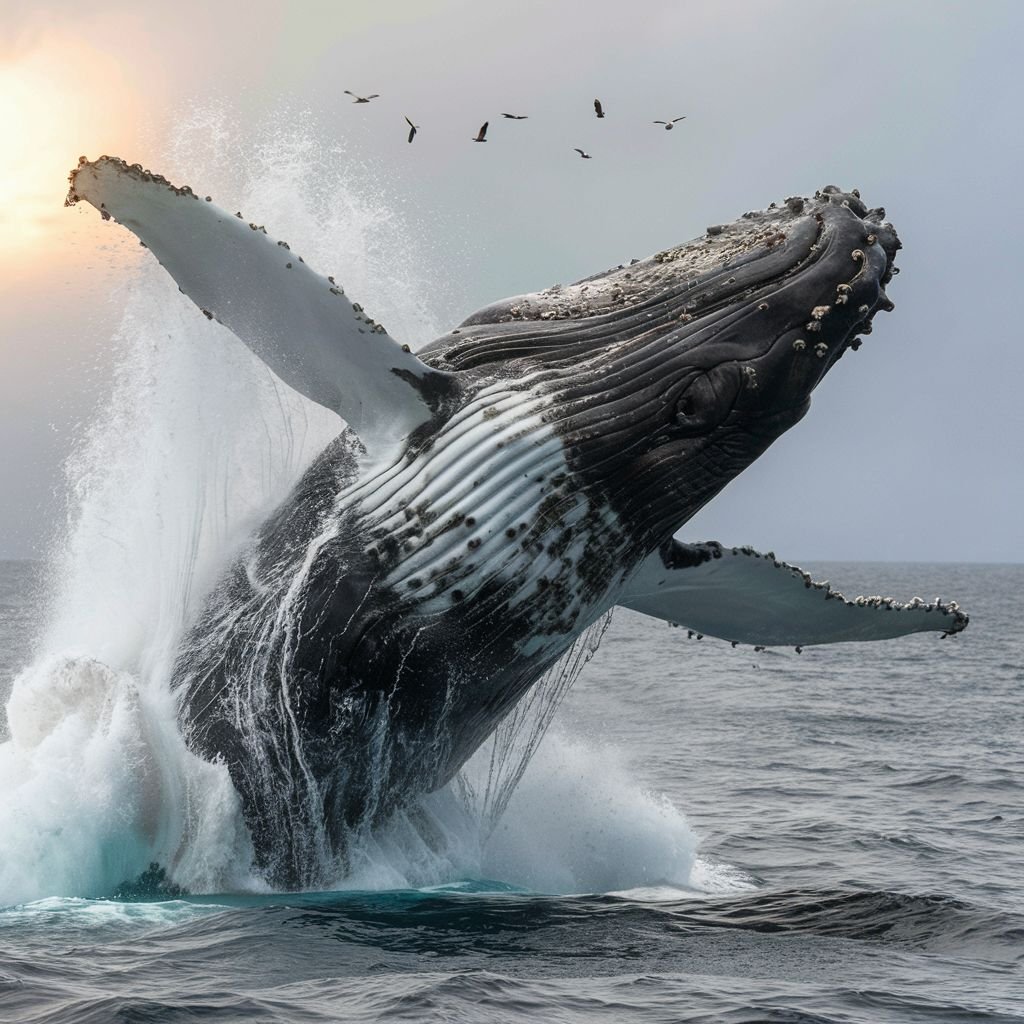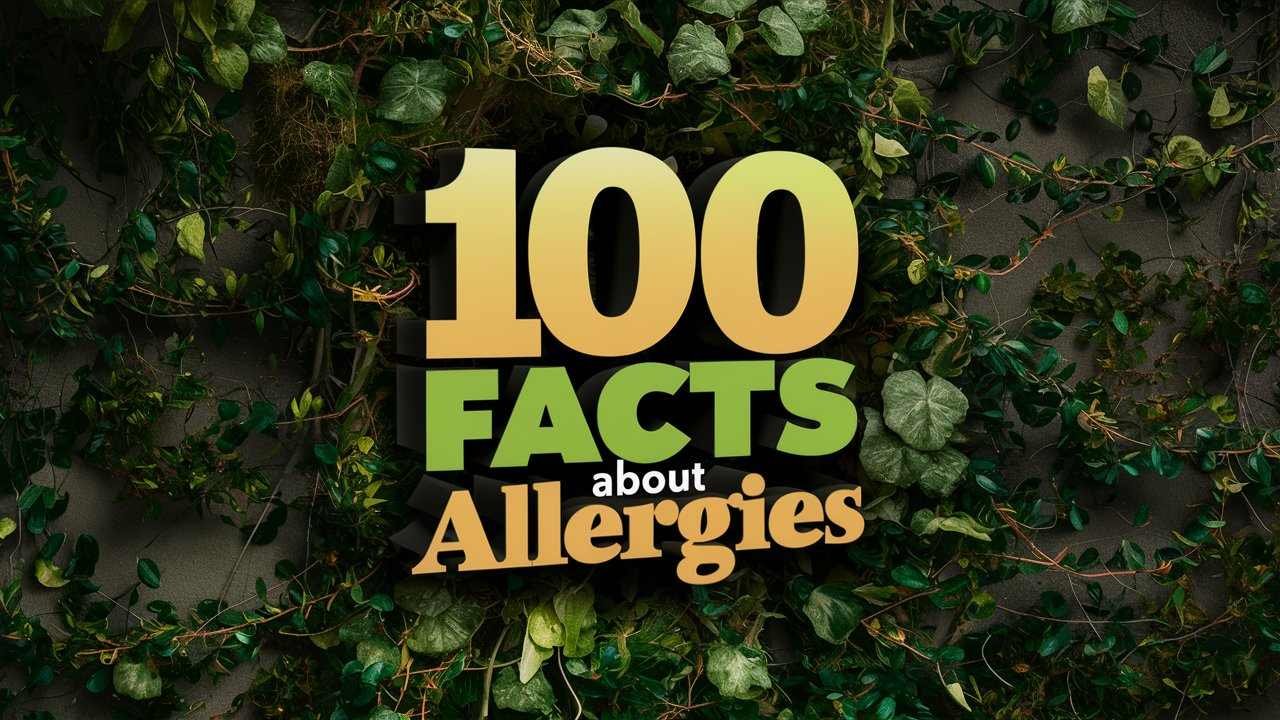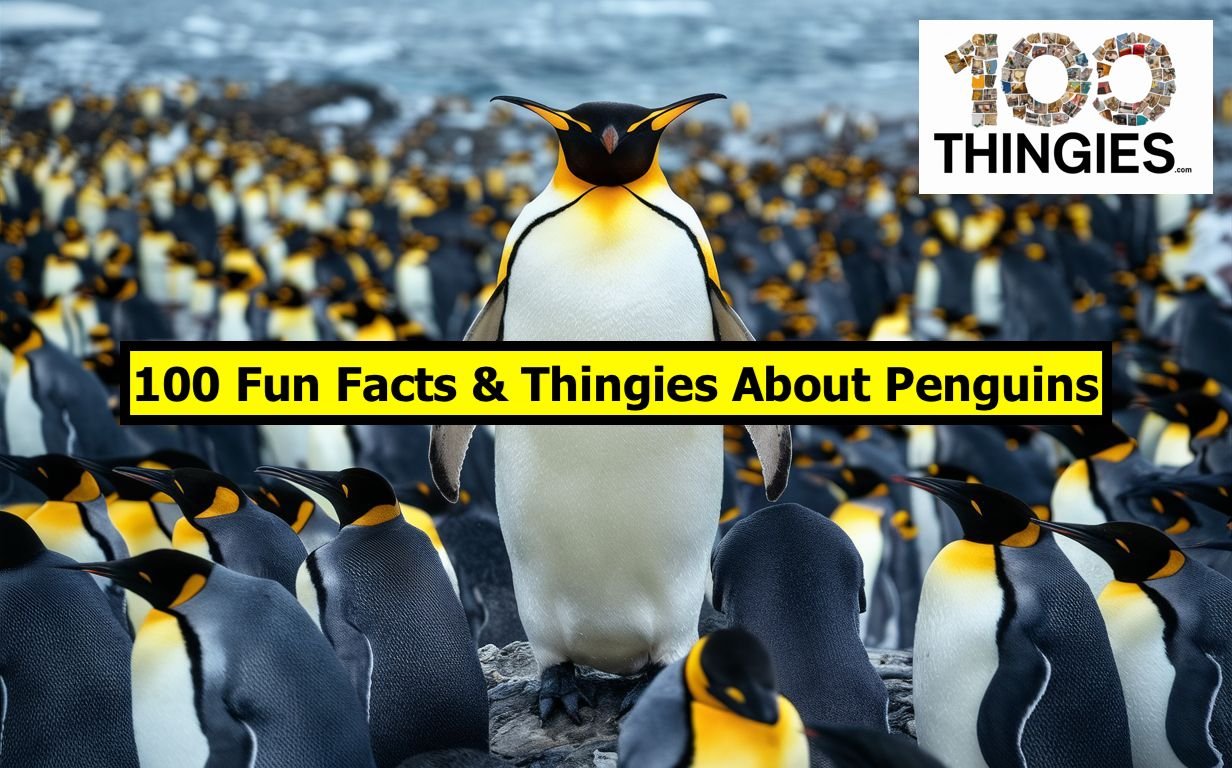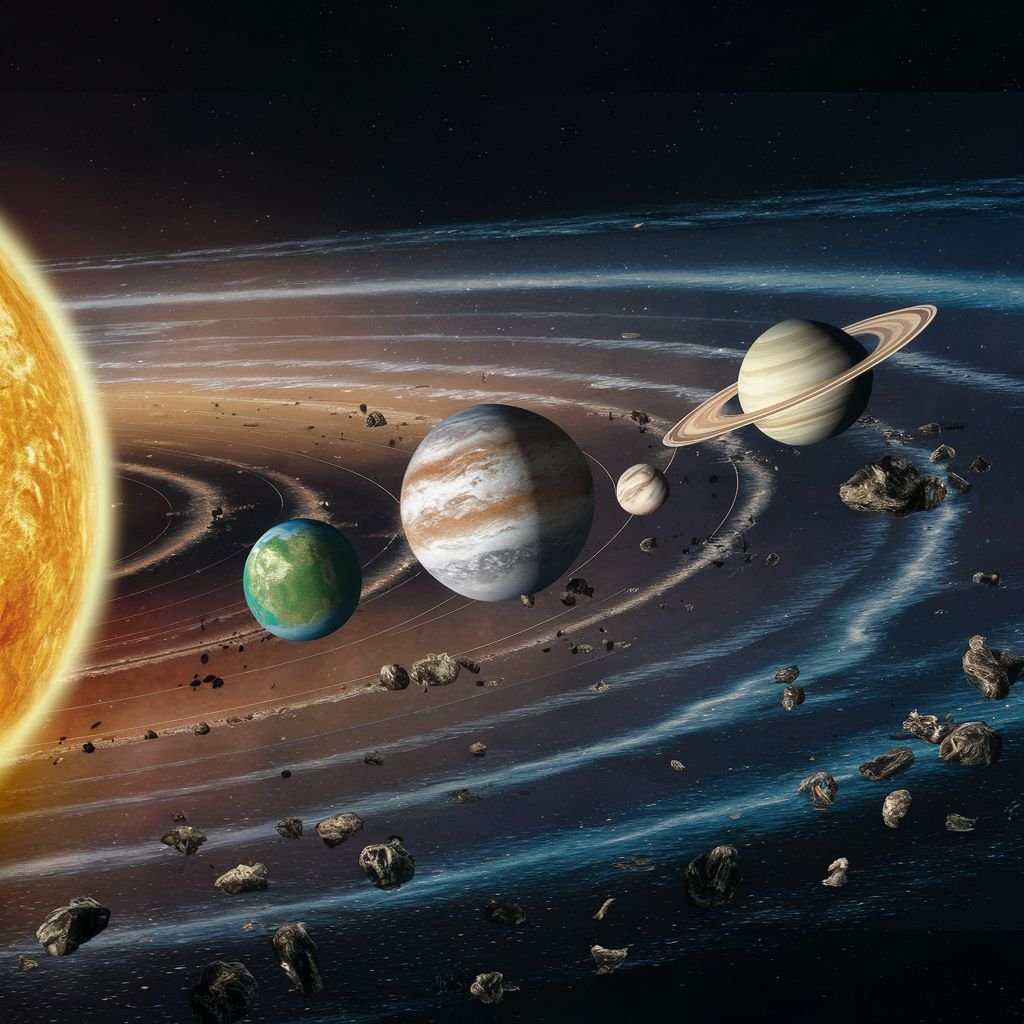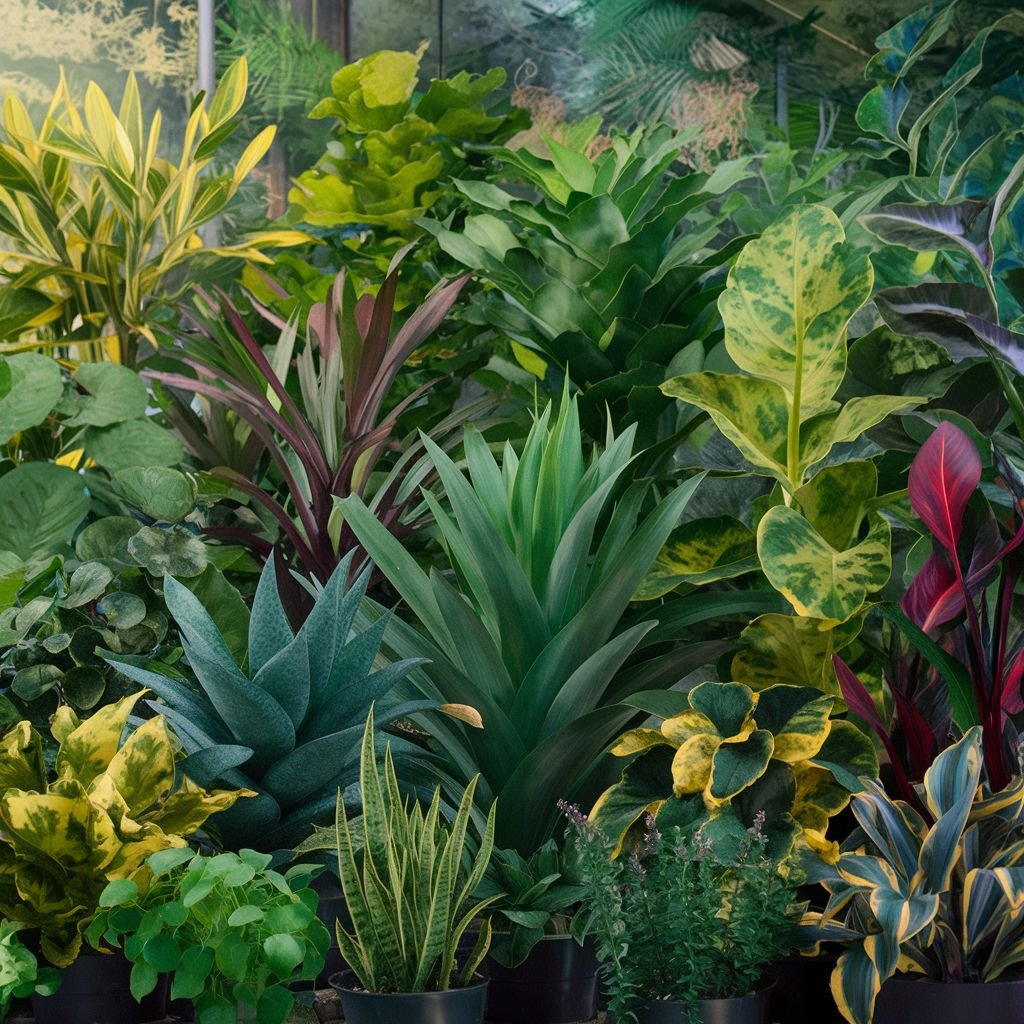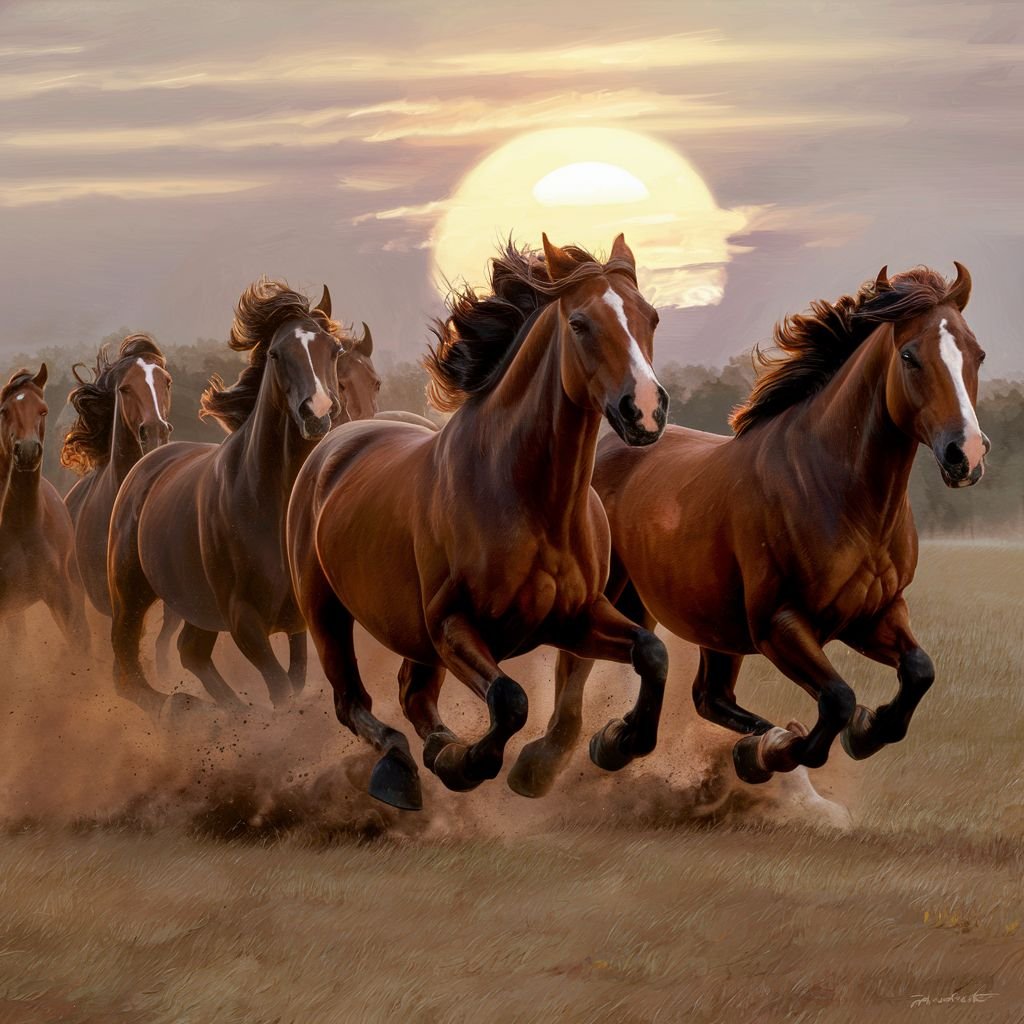
Here’s a list of 100 thingies about horses worth knowing!
1. Horses Have Been Domesticated for Over 5,000 Years
Archaeological evidence suggests that horses were first domesticated in the Eurasian Steppes around 3500 BCE, significantly impacting transportation, agriculture, and warfare.
2. There Are Over 300 Breeds of Horses
The vast array of horse breeds includes the swift Arabian, the powerful Clydesdale, and the gentle Shetland pony, each bred for specific tasks and environments.
3. Horses Can Sleep Both Standing Up and Lying Down
Horses can lock their leg joints to sleep standing without falling over, allowing them to quickly flee predators if necessary. They also lie down for deeper sleep.
4. The Przewalski’s Horse Is the Only Truly Wild Horse Species Remaining
Once considered extinct in the wild, Przewalski’s horses have been reintroduced to their native habitats in Mongolia, thanks to conservation efforts.
5. Horses Have a Wide Field of Vision
With eyes on the sides of their heads, horses have a nearly 360-degree field of vision. They do have blind spots directly in front and behind them.
6. The Fastest Recorded Sprinting Speed of a Horse Was 55 mph
The Thoroughbred racehorse Winning Brew holds the Guinness World Record for the fastest speed of a racehorse, clocking in at 43.97 mph.
7. Horses Have Around 205 Bones in Their Skeleton
The exact number can vary slightly due to differences in the number of tail vertebrae among individual horses.
8. A Horse’s Teeth Take Up More Space in Their Head Than Their Brain
This adaptation helps them grind down fibrous plant material. A mature horse’s brain weighs around 22 ounces, much lighter than its extensive set of teeth.
9. Horses Can Communicate Through Facial Expressions
Researchers have identified at least 17 distinct facial movements in horses, used to communicate with their human handlers and each other.
10. The Horse Galloped into the Record Books for Long-Distance Travel
The record for the longest journey by horse is held by the “Long Riders’ Guild,” documenting rides across continents and covering thousands of miles.
11. Foals Can Stand and Run Shortly After Birth
To escape predators, wild horses needed to be able to move with the herd soon after birth, leading to foals standing and running within a few hours of being born.
12. Horses Have Been Used in Therapy for Centuries
Equine-assisted therapy helps individuals with physical, emotional, and psychological challenges, taking advantage of the horse’s gentle nature and the bond formed between horse and rider.
13. The Term “Horsepower” Is Derived From Horses
Engineer James Watt coined the term in the 18th century to compare the output of steam engines to the work done by draft horses, standardizing a measure of power.
14. Horses Have an Excellent Sense of Balance
A horse’s sense of balance is finely tuned, aiding their ability to carry riders, navigate difficult terrain, and perform intricate movements in dressage.
15. The Akhal-Teke Breed Is Known for Its Metallic Sheen
Originating from Turkmenistan, the Akhal-Teke’s coat has a distinctive metallic sheen, making it one of the most visually stunning horse breeds.
16. Ponies Are Not Baby Horses
Ponies are small horse breeds with distinct characteristics. Baby horses are called foals.
17. The Lipizzaner Breed Performs Classical Dressage
The Lipizzaner horses, associated with the Spanish Riding School of Vienna, are famous for their ability to perform complex movements known as “airs above the ground.”
18. Horses’ Hooves Are Made of the Same Protein as Human Hair and Nails
The protein keratin makes up both human hair and nails and the hooves of horses, providing strength and resilience.
19. Horses Can Drink Up to 10 Gallons of Water a Day
Depending on their size, activity level, and the weather, horses need a significant amount of water to stay hydrated.
20. The Icelandic Horse Can Perform Five Gaits
While most horses have three natural gaits (walk, trot, and canter/gallop), the Icelandic horse is unique in its ability to perform two additional gaits: the tölt and the flying pace.
21. Horses Have Played a Crucial Role in Human History
Horses have been integral to the development of civilizations across the globe, serving as a means of transport, an asset in warfare, and a source of labor in agriculture. Their speed and endurance enabled communications over vast distances through mounted messengers and postal systems. The domestication of horses marked a significant turn in human history, allowing for faster travel and the expansion of territories.
22. The Arabian Horse Has a Unique Skeleton Structure
The Arabian horse, one of the oldest and most recognizable breeds, is noted for its endurance and speed. A unique feature of this breed is that it often has one less rib, one less lumbar vertebra, and one or two fewer tail vertebrae than other horses. This skeletal structure contributes to the breed’s distinctive silhouette and agility.
23. Horses Can Show Affection Through “Blowing”
Horses greet each other by blowing in each other’s nostrils, which is considered a sign of affection and recognition. This behavior can also extend to humans, where a horse may blow softly towards a person it trusts or feels comfortable with, indicating a bond or a desire for interaction. Understanding these subtle social cues can enhance the human-horse relationship.
24. The Shire Horse Is the World’s Largest Horse Breed
The Shire horse, originating from the United Kingdom, is the tallest horse breed and can reach over 17 hands (68 inches) in height. These gentle giants are known for their incredible strength and were historically used for pulling heavy loads in industrial and agricultural settings. Despite their imposing size, Shire horses have a calm and friendly temperament, making them excellent work partners and companions.
25. Horses Have a Remarkable Memory
Horses possess an excellent long-term memory, particularly for places and people, which is essential for their survival in the wild. They can remember past experiences, both positive and negative, which can influence their behavior and training. This ability to remember also plays a role in the strong bonds horses can form with their human caretakers and other horses in their herd.
26. Horses’ Eyes Are Among the Largest of Any Land Mammal
The large size of a horse’s eyes provides them with a broad field of vision, aiding in their ability to detect predators and navigate their environment. Their eyes are positioned on the sides of their head, allowing for nearly 360-degree vision. This wide field of view is crucial for a prey animal, enabling horses to see potential threats from almost any direction.

27. The Mustang Is a Symbol of the American West
Mustangs are wild horses descended from Spanish horses brought to the Americas in the 16th century. They have become an enduring symbol of the freedom and spirit of the American West, roaming in feral herds across public lands. Efforts to manage and protect these iconic animals continue, as they represent a significant part of American heritage and the natural history of the continent.
28. Horses Can Express Emotions Through Their Ears
A horse’s ears are highly expressive and can indicate their mood or focus of attention. Ears pointed forward signify alertness or interest, while ears pinned back can indicate irritation or anger. Understanding these signals can help handlers and riders gauge a horse’s feelings and intentions, improving communication and safety during interactions.
29. The Friesian Horse Is Known for Its Graceful Movement
Originating from the Netherlands, the Friesian horse is renowned for its beautiful and elegant appearance, characterized by a shiny black coat, long flowing mane, and tail, and feathering on the legs. These horses are highly sought after for dressage and driving due to their powerful yet graceful movement and excellent temperament. The breed’s majestic bearing and versatility have made it a favorite in film and television.
30. Ponies Are Hardy and Intelligent
Ponies are not merely small horses; they often possess a sturdier build, thicker coats, and a remarkable level of intelligence and hardiness. These traits have evolved to help them survive in harsh environments, from the Shetland Isles to the mountains of Wales. Ponies are known for their versatility, excelling in everything from pulling carts to participating in children’s riding competitions, showcasing their adaptability and enduring appeal.
31. Horses Can Communicate with Humans Through Body Language
Horses are highly sensitive to human body language, able to read and respond to cues that humans might not even realize they’re giving. This ability makes them excellent partners in therapeutic settings, as they can mirror and respond to the emotions and behaviors of the humans around them. Understanding and harnessing this communicative capability can enhance training, riding, and care practices, fostering a deeper bond between horses and humans.
32. The Curly Horse Has a Unique Hypoallergenic Coat
The Curly Horse is distinguished by its unique curly coat, mane, and tail, which are not only visually striking but also hypoallergenic, making them an ideal choice for individuals with allergies to horses. This breed exhibits a wide range of body types and is versatile, excelling in various disciplines from dressage to rodeo. The origin of the Curly Horse’s distinctive coat is still a subject of study, with the trait appearing in various horse populations around the world.
33. Horses Have Played Vital Roles in Warfare Throughout History
From the chariots of ancient civilizations to the cavalry units of the World Wars, horses have been integral to military operations across the globe. Their speed, agility, and power made them invaluable for reconnaissance, charges, and the transportation of troops and supplies. The bond between war horses and their riders was often deep, as they relied on each other for survival in challenging conditions.
34. The Lipizzaner Breed Is Known for the “Airs Above the Ground”
The Lipizzaner breed, associated with the Spanish Riding School in Vienna, Austria, is famous for performing classical dressage movements known as “airs above the ground.” These highly skilled maneuvers, including the levade, courbette, and capriole, demonstrate the extraordinary training and athleticism of both horse and rider. The breed’s history dates back to the 16th century, with a strong emphasis on preserving its quality and classical training methods.
35. Draft Horses Were Indispensable in Agriculture and Industry
Before the advent of modern machinery, draft horses were the powerhouse behind agriculture and industry, performing tasks such as plowing fields, hauling heavy loads, and powering machines through treadmills. Breeds like the Clydesdale, Belgian, and Percheron were bred for their strength and endurance, contributing significantly to the development of societies by increasing the efficiency of farming and transportation.
36. The Akhal-Teke Is Known for Its Endurance and “Metallic” Coat
Originating from Turkmenistan, the Akhal-Teke is renowned for its incredible endurance and distinctive shiny, “metallic” coat, which comes in various colors, including gold, palomino, and black. The breed’s slim, athletic build and resilience make it an excellent long-distance racer and sport horse. The Akhal-Teke’s striking appearance and capabilities have made it a national treasure in Turkmenistan, featured on postage stamps and in folklore.
37. Horses Have a Unique Ability to Influence Human Heart Rates
Research has shown that interacting with horses can lead to reduced human heart rates and lower stress levels, indicating a calming effect that horses can have on people. This phenomenon is utilized in equine-assisted therapy and learning programs, where horses help individuals with emotional and psychological healing processes. The mutual regulation of heart rates enhances the therapeutic relationship between horses and humans, providing comfort and promoting relaxation.
38. The Miniature Horse Is Bred for Its Small Size
Despite their diminutive stature, Miniature Horses are proportionally similar to their larger counterparts and are recognized for their friendly and curious nature. They are not considered ponies but rather small horses and are used for various activities, including companionship, show competition, and as therapy animals, where they visit hospitals and care facilities to provide comfort to patients. Miniature Horses require the same care as larger horse breeds, including proper nutrition, veterinary attention, and social interaction.
39. Horses’ Coats Change with the Seasons
Horses grow a thicker coat in the winter to protect against cold temperatures and shed this coat in the spring as the weather warms up. This natural process can be influenced by the horse’s living conditions, nutrition, and overall health. In some cases, horse owners assist in the shedding process through grooming to help maintain the horse’s comfort and appearance.
40. Horses Can Recognize Emotions in Human Faces
Studies have shown that horses can distinguish between happy and angry human facial expressions, reacting more positively to happy faces. This ability suggests that horses are sensitive to human emotional states, further underscoring the deep connection possible between horses and humans. This emotional intelligence contributes to the horse’s role as a companion and therapy animal, capable of engaging in meaningful interactions with people.
41. The Andalusian Horse Has a Rich History in Spain
The Andalusian horse, also known as the Pure Spanish Horse, boasts a lineage that dates back thousands of years in Spain. Renowned for its noble appearance, intelligence, and versatility, the Andalusian has been prized by royalty and horse enthusiasts alike. Its influence extends to many modern horse breeds, and it excels in various disciplines, including dressage, driving, and as a highly regarded stock horse in traditional Spanish ranching.
42. Horses Exhibit a Wide Range of Coat Colors and Patterns
Horse coats come in a variety of colors, including bay, black, chestnut, gray, and palomino, and patterns like pinto, roan, and appaloosa. These colors and patterns are the result of complex genetics, and certain breeds are known for specific colors. Understanding horse coat genetics is important for breeders aiming to produce horses of particular colors or patterns.
43. Horses’ Hooves Grow Continuously
A horse’s hooves are akin to human fingernails and grow continuously, requiring regular trimming by a farrier every six to eight weeks to maintain their shape and health. Proper hoof care is crucial for preventing lameness and other hoof-related issues. The adage “no hoof, no horse” underscores the importance of hoof health in the overall well-being of horses.
44. The Morgan Horse Is Known for Its Versatility
Originating in the United States, the Morgan horse is known for its versatility, excelling in disciplines from dressage to driving and western events. Morgans are characterized by their compact, muscular build, friendly disposition, and strong work ethic. The breed’s adaptability and willingness to please have made it a favorite among equestrians of all ages and skill levels.
45. Horses Have Played a Significant Role in Mythology and Folklore
Throughout history, horses have featured prominently in mythology and folklore, symbolizing freedom, power, and grace. From the winged Pegasus of Greek mythology to the eight-legged Sleipnir of Norse legends, horses have captivated the human imagination, serving as mounts for gods and heroes and playing pivotal roles in countless stories and myths.
46. Equine-Assisted Activities Benefit People with Disabilities
Equine-assisted activities and therapies, including therapeutic riding and hippotherapy, have been shown to improve motor skills, balance, and emotional well-being in individuals with disabilities. The natural gait of the horse simulates human walking patterns, which can help improve muscle tone and strength in riders. The unique bond formed between horse and rider also promotes confidence, patience, and empathy.
47. The Belgian Draft Horse Is One of the Strongest Horse Breeds
Belgian draft horses are among the strongest horse breeds, capable of pulling heavy loads and performing demanding farm work. Originating from the Brabant region of Belgium, these gentle giants are distinguished by their muscular build and calm temperament. Belgians have been used historically for heavy haulage and agriculture, and today they are also appreciated for show and recreational purposes.
48. Horses Are Capable of Complex Learning and Problem-Solving
Horses possess a remarkable capacity for learning and problem-solving, demonstrated by their ability to navigate obstacle courses, open gates, and learn a wide range of commands and cues from their human handlers. Positive reinforcement and consistent training methods help in harnessing these cognitive abilities, enhancing the horse’s performance and the safety of horse-human interactions.
49. The Gypsy Vanner Horse Is Known for Its Distinctive Appearance
The Gypsy Vanner, also known as the Gypsy Cob or Irish Cob, is renowned for its striking appearance, characterized by a flowing mane and tail, heavy feathering on the legs, and a strong, compact build. Originally bred by the Romani people to pull their vardoes, or living wagons, across the British Isles, Gypsy Vanners are now popular for their beauty, temperament, and versatility in various equestrian disciplines.
50. Horses Facilitate Conservation and Land Management Efforts
In certain areas, horses are used in conservation and land management efforts to maintain and restore natural habitats. Their grazing habits can help control invasive plant species, reduce wildfire risks by consuming underbrush, and promote biodiversity. Additionally, horses are used in rewilding projects to help restore historical ecosystems and improve the health of landscapes.
51. The Paso Fino Is Renowned for Its Smooth Gait
The Paso Fino, whose name means “fine step,” is a breed known for its natural, four-beat, lateral ambling gait, making it one of the smoothest riding horses in the world. Originating from Spanish stock brought to the Americas, the breed’s distinct gait provides an exceptionally comfortable ride, making it a favorite for long hours in the saddle. The Paso Fino demonstrates this gait from birth, showcasing a blend of elegance, athleticism, and grace.
52. Horses Can Form Deep Emotional Bonds with Other Horses and Humans
Horses are highly social animals, capable of forming close relationships with herd members and human caregivers. These bonds are based on trust, communication, and mutual respect, often leading to profound companionship. The loss of a companion, whether equine or human, can deeply affect a horse, underscoring the depth of their emotional capacities.
53. The American Quarter Horse Excels at Sprinting Short Distances
The American Quarter Horse is named for its ability to outdistance other horse breeds in races of a quarter mile or less, showcasing incredible bursts of speed. With its muscular build, compact body, and versatile abilities, the American Quarter Horse is the most popular breed in the United States. It excels in various disciplines beyond racing, including rodeo events, western pleasure, and working cattle.
54. Horses Have Been Integral to the Development of Cultures Worldwide
Horses have significantly influenced many cultures around the globe, shaping economies, warfare tactics, and social structures. In many indigenous cultures, horses are revered and integrated into spiritual practices and daily life. The horse’s role in ceremonies, stories, and art highlights its importance beyond a mere beast of burden or war.
55. The Haflinger Breed Originates from Austria and Northern Italy
Characterized by its chestnut coat and flaxen mane and tail, the Haflinger is a versatile and hardy breed known for its friendly disposition and work ethic. Developed in the mountains of Austria and Northern Italy, Haflingers are used in agriculture, forestry, and therapeutic riding programs, thanks to their gentle nature and sturdy build. Their sociable temperament makes them excellent family horses.
56. Some Horses Display Homing Instincts
Horses can possess strong homing instincts, allowing them to find their way back to their stable or pasture from considerable distances. This remarkable sense of orientation was crucial in historical contexts, where horses needed to navigate vast landscapes without human guidance. Today, this instinct can still be observed in horses that become loose or are taken on long journeys.
57. The Appaloosa Is Known for Its Distinctive Spotted Coat
The Appaloosa breed features a unique range of coat patterns, including leopard, blanket, snowflake, and marble. Native to North America and developed by the Nez Perce people, the Appaloosa’s striking appearance is complemented by its versatility, intelligence, and endurance. The breed is celebrated in shows, parades, and competitions, and valued as a working and riding horse.
58. Horse Hoofbeats Have Different Names Based on Their Speed
The sounds made by horse hooves hitting the ground are categorized by speed into walk, trot, canter, and gallop. Each gait produces a distinct rhythm and sound, from the steady four-beat walk to the rapid, thunderous gallop. Understanding these gaits is fundamental in equine care, training, and equestrian sports, highlighting the horse’s diverse capabilities for movement.
59. Equine Vision Is Adapted for Detecting Predators
Horses have eyes positioned on the sides of their heads, providing a broad field of vision ideal for detecting predators. While this placement offers an expansive view, it also creates blind spots directly in front of and behind them, areas where they rely more on other senses. This vision adaptation is a key aspect of the horse’s survival instincts, allowing for early detection of threats in their environment.
60. The Sable Island Horse Lives Wild off the Coast of Canada
The Sable Island horse is a population of feral horses living on Sable Island, Nova Scotia, known for their resilience and ability to thrive in a harsh, isolated environment. These horses, legally protected by the Canadian government, have adapted to limited freshwater and vegetation, demonstrating the horse’s remarkable ability to survive and adapt to diverse conditions. The island and its equine inhabitants are subjects of scientific study and conservation efforts, symbolizing the enduring spirit of wild horses.
61. Horse Colors and Markings Are Highly Variable
Horse coats come in a wide range of colors, including bay, black, chestnut, gray, and palomino, and many breeds feature distinctive markings such as blazes, socks, and stars. These colors and markings not only contribute to the horse’s beauty but also have genetic underpinnings that are of interest to breeders and geneticists. Identifying horses by their unique colors and markings is a traditional part of equine management and culture.
62. The Brumby Is Australia’s Wild Horse
Brumbies are the descendants of escaped or lost horses, dating back to the early European settlers in Australia. These wild horses roam in herds in certain parts of the Australian Outback, symbolizing the untamed spirit of the continent. The management of brumby populations has been a topic of environmental debate, balancing the cultural heritage they represent with the ecological impacts on native ecosystems.
63. Horses Can Show Empathy Towards Other Horses and Humans
Research suggests that horses are capable of recognizing and responding to the emotional states of their fellow herd members and human handlers, exhibiting behaviors indicative of empathy. This emotional attunement enhances social cohesion within herds and can strengthen the bond between horses and humans, underscoring the importance of emotional intelligence in equine welfare and training.
64. The Norwegian Fjord Horse Is One of the World’s Oldest Breeds
Characterized by its muscular build, dun color with primitive markings, and distinctive mane style, the Norwegian Fjord horse is an ancient breed known for its good temperament, strength, and versatility. Archaeological excavations in Norway have revealed evidence of horses that closely resemble the modern Fjord horse, tracing its lineage back thousands of years. The breed’s adaptability has made it suitable for a variety of tasks, from farm work to therapeutic riding programs.
65. Horse Riding Can Improve Human Health and Fitness
Riding a horse engages multiple muscle groups, improves posture, increases core strength, and enhances overall cardiovascular health. Beyond the physical benefits, horseback riding also offers mental health advantages, including stress reduction, increased self-esteem, and a sense of accomplishment. The therapeutic and rehabilitative potential of horse riding is harnessed in equine-assisted therapy programs, benefiting individuals with a wide range of physical and mental health conditions.
66. The Marwari Horse Is Known for Its Unique Ear Shape
Originating from the Marwar region of India, the Marwari horse is distinguished by its inward-curving ear tips, a trait not found in any other horse breed. This ancient breed was once the mount of choice for the Rajput warriors and is celebrated for its loyalty, bravery, and endurance. In recent years, efforts have been made to preserve and promote the Marwari horse, highlighting its cultural significance and historical heritage.
67. Horses’ Whiskers Are Highly Sensitive
The whiskers around a horse’s muzzle and eyes are tactile hairs, or vibrissae, that serve as important sensory tools. These whiskers help horses explore their environment, detect nearby objects, and protect their eyes by triggering a blink reflex when touched. Understanding the functional importance of whiskers emphasizes the need for careful consideration before trimming or removing them for aesthetic reasons.
68. The Knabstrupper Breed Is Famous for Its Spotted Coat
Originating from Denmark, the Knabstrupper breed is known for its distinctive leopard-spotted coat, similar to that of the Appaloosa horse. This striking appearance, along with its good temperament and versatility, makes the Knabstrupper a popular choice for dressage, show jumping, and general riding. The breed’s unique coat pattern is the result of a genetic mutation affecting skin pigmentation.
69. Equine Therapy Supports Mental Health and Development
Equine-assisted therapy utilizes horses to promote emotional growth and learning in individuals with ADD, anxiety, autism, dementia, depression, and other mental health issues. Interacting with horses in a therapeutic setting can foster skills such as communication, confidence, empathy, and self-awareness. The non-judgmental nature of horses, combined with their sensitivity to human emotions, creates a unique environment conducive to healing and personal development.
70. The Genetic Basis of Horse Coat Colors Is Complex
The variety of horse coat colors and patterns is the result of complex genetic mechanisms involving multiple genes. Researchers have identified specific genes responsible for base colors and patterns, as well as those that influence dilution and spotting. Advances in genetic testing have made it possible to predict coat colors of offspring, manage genetic diseases, and contribute to breeding programs focused on preserving rare colors and patterns.
71. Horses Have an Incredible Range of Hearing
Horses can hear frequencies much lower and higher than humans can, allowing them to detect sounds from a great distance and even those that humans cannot perceive. This acute sense of hearing helps them to be aware of predators and other potential threats, as well as to communicate with other horses over long distances. Their ears can rotate nearly 180 degrees, enabling them to pinpoint the source of a sound with remarkable accuracy.
72. The Role of Horses in Therapy Has Expanded Beyond Riding
In addition to riding, horses are used in ground-based therapies, such as grooming, feeding, and leading exercises, which have been found to offer psychological benefits. These activities can promote mindfulness, reduce stress, and improve mood, making equine-assisted therapy a versatile tool for mental health. The physical and emotional care of horses in a therapeutic setting fosters responsibility, compassion, and personal growth in participants.
73. Wild Horses Still Roam in Several Parts of the World
Apart from the well-known mustangs of North America and brumbies of Australia, wild horse populations exist in regions like the steppes of Central Asia, where the Przewalski’s horse has been reintroduced, and in parts of Europe, such as the Camargue horses in France. These free-roaming horses are often subjects of conservation efforts, as they represent the last remnants of the world’s once vast wild horse populations.
74. Horses Can Express Joy and Playfulness
Horses often engage in playful behavior, both with other horses and humans, demonstrating their capacity for joy and sociability. This can include running, bucking, and engaging in mock fights, as well as playing with toys in their environment. Recognizing and encouraging this playful behavior is important for a horse’s mental and physical well-being.
75. The Influence of Horses on Human Culture Is Immeasurable
From art and literature to mythology and warfare, horses have deeply influenced human cultures across the globe. They have been depicted in some of the earliest known cave paintings, immortalized in statues and works of literature, and have played central roles in countless historical events. The horse’s partnership with humans has been one of mutual benefit and profound impact, shaping the course of civilizations.
76. Equine Hoof Care Is Critical for Horse Health
Proper hoof care, including regular trimming and, if necessary, shoeing, is crucial to prevent lameness and other hoof-related problems. The hooves support the horse’s weight and absorb shock when moving. Neglecting hoof care can lead to serious conditions such as laminitis or navicular disease, underscoring the importance of routine maintenance and examination by a qualified farrier.
77. Horse Grooming Is Essential for Health and Bonding
Grooming not only keeps a horse’s coat, mane, and tail clean and tangle-free but also serves as an important bonding activity between horses and humans. It allows for the early detection of health issues like cuts, swelling, or skin problems. The physical contact and attention during grooming sessions can strengthen the trust and connection between a horse and its handler.
78. Horses Played a Key Role in the Expansion of Empires
Throughout history, horses have been indispensable in the conquest and expansion of territories. Their speed and endurance enabled armies to move quickly over vast distances, while their power and agility were decisive in battle. The ability to use horses effectively in warfare was often a significant advantage in historical conflicts.
79. The Evolution of Horse Breeds Reflects Human Needs and Preferences
Over centuries, selective breeding has produced horse breeds that excel in specific tasks, such as racing, jumping, pulling heavy loads, or endurance riding. Breed development has been influenced by the geographical, economic, and cultural needs of human societies, resulting in the incredible diversity of breeds we see today.
80. Horses Can Help Children Develop Responsibility and Confidence
Caring for a horse requires a significant level of responsibility, including feeding, grooming, and exercise. For children and adolescents, involvement in horse care and riding can foster a sense of responsibility, discipline, and self-confidence. The challenges and achievements associated with horsemanship provide valuable life lessons and personal development opportunities.
81. Horses Have Distinct Personalities and Temperaments
Just like humans, horses exhibit a wide range of personalities, from bold and adventurous to calm and gentle. Their temperament can significantly influence their suitability for various disciplines, compatibility with riders, and behavior in training and social situations. Understanding a horse’s personality is crucial for building a successful and harmonious relationship.
82. The Historic Significance of Horse Racing
Horse racing, often referred to as the “Sport of Kings,” has a long and storied history dating back to ancient civilizations. It has evolved from a form of public entertainment and royal pastime into a major international industry with thoroughbred racing at its core. The breeding, training, and racing of horses have led to significant advancements in veterinary care and equine genetics.
83. Horses Exhibit a Flight or Fight Response
As prey animals, horses are hardwired to exhibit a flight or fight response when faced with potential threats. This instinctual reaction underscores the importance of trust and confidence in the horse-human relationship, as well as the need for proper training and socialization to help horses manage their natural instincts in a domesticated environment.
84. The Contribution of Horses to Agricultural Development
Before the advent of mechanized equipment, horses were indispensable in agriculture for plowing fields, transporting crops, and powering machinery. The strength and endurance of draft horses, in particular, significantly increased the efficiency of farming practices, contributing to the development of modern agriculture.
85. Horses Require Social Interaction
Horses are inherently social animals that thrive in the company of other horses. Isolation can lead to stress, anxiety, and behavioral issues. Providing opportunities for social interaction, whether through group turnout or stable arrangements that allow for visual and physical contact, is essential for their mental well-being.
86. The Art of Dressage Demonstrates the Highest Levels of Horse Training
Dressage, often described as “horse ballet,” is an equestrian discipline that showcases the training and harmony between horse and rider. Through a series of precise movements and commands, dressage demonstrates the horse’s natural athletic ability and willingness to perform, reflecting the pinnacle of equine grace, discipline, and communication.
87. Horse Senses Are Highly Developed
In addition to their acute hearing and broad field of vision, horses have an exceptional sense of smell and a sensitive touch. These heightened senses help them navigate their environment, detect predators, and communicate with other horses. Riders and handlers can harness these senses to enhance training and care practices.
88. The Paso Fino’s Gait Is Naturally Smooth
The Paso Fino breed is celebrated for its smooth, natural gait, which offers a comfortable ride for equestrians of all ages. This distinctive gait, which can be maintained over long distances, showcases the breed’s elegance and stamina, making it a favorite for pleasure riding and competitive events.
89. Horseback Riding Has Physical and Mental Health Benefits
Riding a horse is not only an enjoyable activity but also provides numerous health benefits, including improved balance, core strength, coordination, and cardiovascular fitness. The psychological benefits of horseback riding, such as stress reduction and enhanced mood, contribute to its popularity as a recreational and therapeutic activity.
90. The Mustang Symbolizes the Spirit of Freedom
The mustang, a free-roaming horse of the American West, has become an enduring symbol of freedom, resilience, and the untamed wilderness. Despite challenges related to habitat loss and management controversies, the mustang represents the enduring legacy of the horse in American history and culture.
91. Horses Can Learn to Understand Symbols and Signs
Research has shown that horses can learn to associate specific symbols or signs with actions or outcomes, such as indicating their preference for wearing a blanket. This cognitive ability demonstrates not only their capacity to communicate with humans but also their potential for understanding abstract concepts, enhancing the way we interact and care for them.
92. The Friesian Horse is Recognized for Its Black Coat
Originating from the Netherlands, the Friesian horse is renowned for its striking black coat, majestic mane, and tail, and feathering on the legs. Friesians are often featured in films and live performances due to their elegant appearance and graceful movement. Historically used as war horses, today they excel in dressage and driving, admired for their beauty and temperament.
93. Horses Have Been Depicted in Art for Millennia
From the cave paintings at Lascaux to contemporary equestrian statues, horses have been a favorite subject in art, symbolizing power, grace, and freedom. Artists have captured the essence of the horse in various mediums, reflecting the animal’s significance across cultures and time periods. These depictions not only celebrate the beauty of horses but also document their evolving roles in human society.
94. Equine Color Genetics is a Complex Field
The coat color of horses is determined by a combination of genes, with the basic colors influenced by the extension (E) and agouti (A) genes, among others. Beyond these, a variety of genes contribute to dilutions, spotting patterns, and unique markings. Genetic testing can identify potential colors of offspring, assist in breeding decisions, and even solve mysteries of heritage in certain cases.
95. Horse Hooves are Remarkably Strong
A horse’s hoof is made of keratin, the same protein that forms human nails and hair, but it’s incredibly tough and capable of supporting the horse’s weight and the rigors of running and jumping. Proper care, including regular trimming, cleaning, and protection from harsh conditions, is essential to prevent issues such as cracking or infections, which can significantly impact a horse’s health and performance.
96. The Relationship Between Humans and Horses is Mutually Beneficial
Horses have provided humans with transportation, labor, companionship, and leisure, significantly shaping human history and development. In return, humans have cared for horses, offering shelter, food, medical care, and protection. This symbiotic relationship has evolved over thousands of years, with each species influencing the other’s way of life.
97. Horses Play a Key Role in Conservation Grazing
In certain ecosystems, horses are used in conservation grazing to manage and maintain landscapes, promoting biodiversity by controlling invasive plant species and encouraging the growth of native flora. This natural management technique highlights the horse’s role in environmental conservation and the maintenance of habitats for various wildlife species.
98. The Nokota Horse Preserves the Legacy of the American Plains Horses
The Nokota horse, native to the North Dakota Badlands, represents the spirit and heritage of the native horses of the American Plains. These hardy, versatile horses, descended from the mounts of Native American tribes and early ranch stock, are recognized for their endurance, intelligence, and the effort to preserve them reflects a commitment to maintaining a living link to America’s equine heritage.
99. Horse Whispering Demonstrates the Power of Gentle Training Methods
Horse whispering, or natural horsemanship, emphasizes understanding and communication between horse and trainer, using gentle techniques rather than force. This approach builds trust and respect, demonstrating that sensitivity and patience can achieve remarkable results in training and managing horses. The principles of horse whispering have influenced modern equestrian practices, promoting a more empathetic and informed approach to horse care.
100. Horses Continue to Inspire and Enrich Human Lives
Whether as companions, athletes, workers, or healers, horses continue to play a significant role in the lives of people around the world. Their beauty, strength, and spirit inspire art, literature, and film, while their therapeutic presence supports physical and emotional healing. The enduring bond between humans and horses is a testament to the profound impact these magnificent creatures have on our lives, reminding us of the importance of preserving and cherishing these relationships for generations to come.

